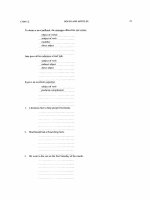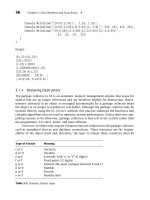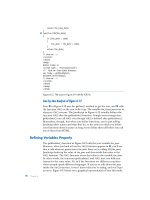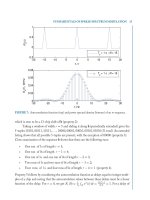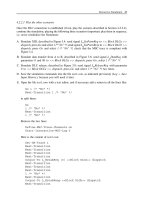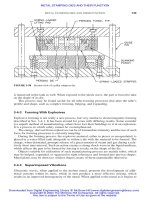Best of Ruby Quiz Pragmatic programmers phần 3 doc
Bạn đang xem bản rút gọn của tài liệu. Xem và tải ngay bản đầy đủ của tài liệu tại đây (168.95 KB, 29 trang )
QUIZ 22. LEARNING TIC-TAC-TOE 52
Quiz
22
Answer on pag e 225
Learning Tic-Tac-Toe
This Ruby Quiz is to implement some AI for playing tic-tac-toe, with
a catch: you’re not allowed to embed any knowledge of the game into
your creation beyond making legal moves and recognizing that it has
won or lost.
Your program is expected to “learn” from the games it plays, until it
masters the game and can play flawlessly.
Tic-tac-toe is a very easy game played on a 3×3 board like this:
| |
+ +
| |
+ +
| |
Two players take turns filling a single open square with their symbol.
The first person to play uses X s, and the other player uses Os. The first
player to get a run of three symbols across, down, or diagonally wins.
If the board fills wi thout a run, the game is a draw. Here’s what a game
won by the X player might end up looking like:
| | X
+ +
| X |
+ +
X | O | O
Submissions can have any inter face but should be able to play against
humans interactively. However, I also suggest making it easy to play
against another AI player so you can “teach” the program faster.
Being able to monitor the learning progression and know when a pro-
gram has mastered the game would be very interesting, if you can find
a way to incorporate it into your solution.
Report erratum
QUIZ 23. COUNTDOWN 53
Quiz
23
Answer on pag e 239
Countdown
Posed by Brian Ca ndler
One of the longest-running quiz shows on British television is called
Countdown. That show has a “numbers round.” Some cards are laid
face down in front of th e host. The top row contains large numbers
(from the set 25, 50, 75, and 100), and the rest are small (1 to 10).
Numbers are duplicated in the cards. Six cards are picked and dis-
played: the choice is made by one of the contestants, who typically will
ask for one large number and five small ones.
Next, a machine called Cecil picks a target number from 100 to 999
at random. The contestants then have 30 seconds to find a way of
combining the source numbers using the normal arithmetic operators
(+, -, *, and /) to make the target number or to get as close as possible.
Each source card can be used just once. The same applies to any
intermediate results (although of course you don’t have to explicitly
show the in termediate results).
For example, if the target number is 522 and the source cards are 100,
5, 5, 2, 6, and 8, a possible solution is as follows:
100 * 5 = 500
5 + 6 = 11
11 * 2 = 22
500 + 22 = 522
or more succinctly, (5 * 100) + ((5 + 6) * 2) = 522. Another solution is
(100 + 6) * 5 - 8 = 522.
Normal arithmetic rules apply. Each step of th e calculation must result
in an integer value.
Report erratum
QUIZ 23. COUNTDOWN 54
The quiz is to write a program that will accept one t arget number and
a list of source numbers and g enerate a solution that calculates the
target or a number as close to the target as possible.
Report erratum
QUIZ 24. SOLVING TACTICS 55
Quiz
24
Answer on pag e 249
Solving Tactics
Posed by Bob Sidebotham
There i s a pencil and paper game, Tactics, played on a 4×4 grid. The
play starts with an empty grid. On each turn, a player can fill in
from one to four adjacent squares, either horizontally or vertically. The
player who fills in the last square loses.
Here’s a sample game to help clarify the previous rules. The board
position at the end of each play is shown:
First player Second player
X X X X X X X X (Turn 1)
_ _ _ _ _ _ _ _
_ _ _ _ _ _ X _
_ _ _ _ _ _
X _
X X X X X X X X (Turn 2)
X X _ _ X X _ X
_ _ X _ _ _ X X
_ _ X _ _ _ X _
X X X X X X X X (Turn 3)
X X _ X X X
X X
_ _ X X _ _ X X
_ _ X
X _ _ X X
X X X X X X X X (Turn 4)
X X X X X X X X
X X X X X X X X
_ _ X X
X _ X X
X X X X (Turn 5
X X X X Second
X X X X player
X
X X X wins!)
Report erratum
QUIZ 24. SOLVING TACTICS 56
Your task is to write a Ruby program that, given only t hese rules, deter-
mines wheth er the first or second player is bound to be the winner,
assuming perfect play. It should do this in a “reasonable” amount of
time and memory—it should definitely take less than a minute on any
processor less than five years old. You get bonus points if you can make
the case that your program actually g ets the right answer for the right
reason!
Report erratum
QUIZ 25. CRYPTOGRAMS 57
Quiz
25
Answer on pag e 259
Cryptograms
Posed by Glenn P. Parker
Given a cryptogram and a dictionary of known words, find t he best
possible solution(s) to the cryptogr am. You get extra points for speed.
Coding a brute-force solution is relatively easy, but there are many
opportunities for the clever optimizer.
A cryptogram is piece of text that has been passed through a simple
cipher that maps all instances of one letter to a different letter. The
familiar rot13
19
encoding is a trivial example.
A solution to a cryptogram is a one-to-one mapping between two sets of
(up to) 26 letters, such that applying the map to the cryptogram yields
the greatest possible number of words in the dictionary.
Both the dictionary and the cryptogram are presented as a set of words,
one per line. The script should output one or more solutions and the
full or part i al mapping f or each solution. A cryptogram might be as
follows:
gebo
tev
e
cwaack
cegn
gsatkb
ussyk
Its solution could be as follows:
mary
had
19
An encoding where the first 13 letters of the alphabet are swapped with the last 13,
and vice versa. In Ruby that’s just
some_string.tr("A-Za-z", "N-ZA-Mn-za-m").
Report erratum
QUIZ 25. CRYPTOGRAMS 58
a
little
lamb
mother
goose
This is solved using the following mapping:
in: abcdefghijklmnopqrstuvwxyz
out: trl.a.m e by ohgdi.s.
(The dots in the “out” side of the mapping indicate unused input letters.)
Three unsolved cryptograms are given. Each cryptogram uses a differ-
ent mapping. The cryptograms may contain a few w ords that are not in
the dictionary (for example, an author’s name is commonly appended
to quoted text in cryptograms). Many published cryptograms also con-
tain punctuation in plain text as a clue to the solver. The following
cryptograms contain no punctuation, since it just confuses dictionary-
based searches:
cryptograms/crypto1.t xt
zfsbhd
bd
lsf
xfe
ofsr
bsdxbejrbls
sbsfra
sbsf
xfe
ofsr
xfedxbejrbls
rqlujd
jvwj
fpbdls
cryptograms/crypto2.t xt
mkr
ideerqruhr
nrmsrru
mkr
ozgcym
qdakm
scqi
oui
mkr
qdakm
scqi
dy
mkr
Report erratum
QUIZ 25. CRYPTOGRAMS 59
ideerqruhr
nrmsrru
mkr
zdakmudua
nja
oui
mkr
zdakmudua
goqb
msodu
cryptograms/crypto3.t xt
ftyw
uwmb
yw
ilwwv
qvb
bjtvi
fupxiu
t
dqvi
tv
yj
huqtvd
mtrw
fuw
dwq
bjmqv
fupyqd
The dictionary I used was2of4brif.txt, available as part of the 12Dicts
package at />Report erratum
Part II
Answers and Discussion
ANSWER 1. MAD LIBS 61
Answer
1
From page 6
Mad Libs
These are a fun little distraction, eh? Actually, I was surprised to
discover (when writing the quiz) how practical this challenge is. Mad
Libs are really just a templating problem, and t hat comes up in many
aspects of programming. Have a look at the “views” in Ruby on Rails
20
for a strong real-world example.
Looking at the problem that way got me to thin king, doesn’t Ruby ship
with a templating engine? Yes, it does.
Ruby includes a standard library called
ERB.
21
ERB allows you to embed
Ruby code into any text document. When that text is run through the
library, the embedded code is run. This can be used to dynamically
build up document content.
For this example, we need only one feature of
ERB. When we run ERB on
a file, any Ruby code inside of the funny-looking <%= %> tags will be
executed, and the value retur ned by that execution code will be inser ted
into the document. Think of this as delayed interpolation (like Ruby’s
#{ }, but it happens when triggered instead of when a String is built).
22
Let’s put ERB to work:
madlibs/erb_madlib.rb
#!/usr/local/bin/ruby -w
# use Ruby' s standard template engine
require "erb"
20
Ruby on Rails, or just Rails to those who know it well, is a popular web application
framework written in Ruby. You can learn more at
/>21
ERB is eRuby’s pure-Ruby cousin. eRuby is written in C and stands for “embedded
Ruby.”
22
You can learn about ERB’s other features from the online documentation at
/>Report erratum
ANSWER 1. MAD LIBS 62
# storage for keyed question reuse
$answers = Hash.new
# asks a madlib question and returns an answer
def q_to_a( question )
question.gsub!(/\s+/, " ") # normalize spacing
if $answers.include? question # keyed question
$answers[question]
else # new question
key = if question.sub!(/^\s*(.+?)\s*:\s*/, "") then $1 else nil end
print "Give me #{question}: "
answer = $stdin.gets.chomp
$answers[key] = answer
unless key.nil?
answer
end
end
# usage
unless ARGV.size == 1 and test(?e, ARGV[0])
puts
"Usage: #{File.basename($PROGRAM_NAME)} MADLIB_FILE"
exit
end
# load Madlib, with title
madlib = "\n#{File.basename(ARGV.first, ' .madlib' ).tr(' _' , ' ' )}\n\n" +
File.read(ARGV.first)
# convert (( )) to <%= q_to_a(' ' ) %>
madlib.gsub!(/\(\(\s*(.+?)\s*\)\)/, "<%= q_to_a(' \\1' ) %>")
# run template
ERB.new(madlib).run
The main principle here is t o convert (( )) to <%= %>, so we can use
ERB. Of course, <%= a noun %> isn’t going to be valid Ruby code, so a
helper method is needed. That’s where q_to_a( ) comes in. It takes t he
Mad L i bs replacements as an argument and returns the user’s answer.
To use t hat, we actually need to convert (( )) to <%= q_to_a(’ ’) %>.
From there, ERB does the rest of the work for us.
Custom Templating
Now for simple Mad Libs, you don’t really need something as robust as
ERB. It’s easy to roll your own solution, and most people did just that.
Let’s examine a custom parsing program.
Report erratum
ANSWER 1. MAD LIBS 63
There are really only three kinds of story elements in our Mad Libs
exercise. There’s ordinary prose, questions to ask the user, and reused
replacement values.
The last of those is the easiest to identify, so let’s start there. If a value
between the (( )) placeholders has already been set by a question, it is
a replacement. That’s easy enough to translate to code:
madlibs/parsed_madlib.rb
# A placeholder in the story for a reused value.
class Replacement
# Only if we have a replacement for a given token is this class a match.
def self.parse?( token, replacements )
if token[0 1] == "((" and replacements.include? token[2 1]
new(token[2 1], replacements)
else
false
end
end
def initialize( name, replacements )
@name = name
@replacements = replacements
end
def
to_s
@replacements[@name]
end
end
Using parse?( ), you can turn a replacement value from the story into a
code element that can later be used to build the final st ory. The r eturn
value of parse?( ) is either false, if the token was not a replacement value,
or the constructed Replacement object.
Inside parse?( ), a token is selected if it begins with a (( and the name
is i n the Hash of replacements. When that is the case, the name and
Hash are stored so the lookup can be made when the time comes. That
lookup is the to_s( ) method.
On to Question objects:
madlibs/parsed_madlib.rb
# A question for the user, to be replaced with their answer.
class Question
# If we see a ((, it' s a prompt. Save their answer if a name is given.
def self.parse?( prompt, replacements )
if prompt.sub!(/^\(\(/, "")
prompt, name = prompt.split(
":").reverse
Report erratum
ANSWER 1. MAD LIBS 64
replacements[name] = nil unless name.nil?
new(prompt, name, replacements)
else
false
end
end
def
initialize( prompt, name, replacements )
@prompt = prompt
@name = name
@replacements = replacements
end
def
to_s
"Enter #{@prompt}: "
answer = $stdin.gets.to_s.strip
@replacements[@name] = answer
unless @name.nil?
answer
end
end
A Question is identified as any token left in the story that starts with ((
and wasn’t a Replacement. The prompt and name, if there was one, are
stored alone with the replacements for later use. A nil value is added
under a requested name in the Hash, so future Replacement objects will
match.
When the to_s( ) method is called, Question will query the user and return
the answer. It will also set the value in the @replacements, if the question
was named.
Stories have only one more element: the prose. Ruby already has an
object for that, a String. Let’s just adapt String’s interface so we can use
it:
madlibs/parsed_madlib.rb
# Ordinary prose.
class String
# Anything is acceptable.
def self.parse?( token, replacements )
new(token)
end
end
No surprises there. All elements left in the story are prose, so parse?( )
accepts anything, returning a simple string.
Report erratum
ANSWER 1. MAD LIBS 65
Here’s the application code that completes the solution:
madlibs/parsed_madlib.rb
# argument parsing
unless ARGV.size == 1 and test(?e, ARGV[0])
puts
"Usage: #{File.basename($PROGRAM_NAME)} MADLIB_FILE"
exit
end
madlib = <<MADLIB
#{File.basename(ARGV.first, ".madlib").tr("_", " ")}
#{File.read(ARGV.first)}
MADLIB
# tokenize input
tokens = madlib.split(/(\(\([^)]+)\)\)/).map do |token|
token[0 1] == "((" ? token.gsub(/\s+/, " ") : token
end
# identify each part of the story
answers = Hash.new
story = tokens.map do |token|
[Replacement, Question, String].inject(
false) do |element, kind|
element = kind.parse?(token, answers) and break element
end
end
# share the results
puts story.join
After some familiar argument-parsing code, we find a three-stage pro-
cess for going from input to finished story. First, the input file is broken
down into tokens. Tokenization is really just a single call to split( ). It’s
important to note that anything captured by parentheses in the Reg-
exp used by split( ) is part of the returned set. This is used to return
(( )) tokens, even though they are the delimiter for split( ). However, the
capturing parentheses are placed to drop the trailing )) . The leading ((
is kept for later token identification. Finally, whitespace is normalized
inside (( )) tokens, in case they run over multiple lines.
In the second stage, each token is converted into a Replacement, Ques-
tion, or String object by the rules we defined earlier. Don’t let that funny-
looking inject( ) call throw you. I could have just used a body of element
or kind.parse?(token, answers), but that keeps checking all the classes
even after it has found a match. The break was added to short-circuit
the process as soon as we find a parser that accepts the token.
The final stage of processing actually creates and displays a story. In
Report erratum
ANSWER 1. MAD LIBS 66
order to understand that sing l e line of code, you need to know that join( )
will ensure all the elements are String objects, by calling to_s( ) on them,
before adding them togeth er.
It’s probably worth noting that while this parsing process is some-
what more involved than the other solutions we have and will examine,
only the final step needs to be repeated if w e wanted to run the same
story again, say for a different user. The parsed format is completely
reusable.
Mini Libs
Let’s examine one more super small solution by Dominik Bathon. Obvi-
ously, this code is a round of golf
23
and not what most of us would
consider pretty, but it still contains some interesting ideas:
madlibs/golfed_madlib.r b
keys=Hash.new { |h, k|
puts "Give me #{k.sub(/\A([^:]+):/, "")}:"
h[$1]=$stdin.gets.chomp
}
puts
"", $*[0].split(".")[0].gsub("_", " "),
IO.read($*[0]).gsub(/\(\(([^)]+)\)\)/) { keys[$1] }
In order to understand this code, start at the final puts( ) call. You don’t
see it used too often, but Ruby’s puts( ) will accept a list of lines to print.
This code is using that. The first of the three lines is just an empty
String that yields a blank line before we print the story.
The second li ne puts( ) is asked to pri nt i s the Mad Lib’s name itself,
which is pulled from the file name. The key to understanding this snip-
pet is to know that the Perlish variable $* is a synonym for ARGV. Given
that, you can see the first command-line argument is read, stripped of
an extension with split( ), and cleaned up (“_” to “ ” translation). The end
result is a human readable title.
The last line is actually the entire Mad Libs story. Again, you see it
accessed through the first member of $*. The gsub( ) call handles the
question asking and replacement in one clever step using a simple Hash.
Let’s take a closer look at that Hash. Jump back to the beginning of the
program now. The Hash uses a default value block to conjure key-value
23
Golf is a sport programmers sometimes engage in to code a solution in a minimal
amount of keystrokes. They will often use surprising code constructs, as long as it shaves
off a few characters. Because of this, the resulting program can be difficult to read.
Report erratum
ANSWER 1. MAD LIBS 67
pairs as they are needed. It prints a question, sub( )ing a key name out if
needed. You can see that the answer is read from the user and shoved
right into the Hash under the $1 key. E xactly what’s in th at $1 variable
is the trick. Notice that the original gsub( ) from the l ower puts( ) call sets
$1 to the entire Mad Libs question. However, the Hash block sometimes
performs another substitution, which overwrites $1. If the substitution
was named, $1 w ould be set to that name. Oth erwise, the sub( ) call
will fail, and $1 will be unaltered. Then, because we’re talking about a
Hash here, future access to the same key will just return the set value,
bypassing the tricky block.
Again, the above previous has a few bad habits, but it also uses some
rare and interesting Ruby idioms to do a lot of work in very little code.
Additional Exercises
1. Extend the Mad Libs syntax to support case changes.
2. Enhance your solution to support the new syntax.
Report erratum
ANSWER 2. LCD NUMBERS 68
Answer
2
From page 8
LCD Numbers
Clearly this problem isn’t too difficult. Hao (David) Tran sent in a golfed
solution (not shown) in less than 300 bytes. Easy or not, this classic
challenge does address topics such as scaling and joining multiline
data that are applicable to many areas of computer programming.
Using Templates
I’ve seen three main strat egi es used for solving the problem. Some use
a template approach, where you have some kind of text representat i on
of y our number at a scale of one. Two might look like this, for example:
[ " - ",
" |",
" - ",
"| ",
" - " ]
Scaling that to any size is a twofold process. First, you need to st retch
it horizontally. The easy way to do that is to grab the second character
of each string (a “-” or a “ ”) and repeat it
-s times:
digit.each { |row| row[1, 1] *= scale }
After that, th e digit needs to be scaled vertically. That’s pretty easy to
do whi l e printing it out, if you want. Just print any line containing a |
-s times:
digit.each do |row|
if row.include? "|"
scale.times { puts row }
else
puts row
end
end
Here’s a complete solution, drawing those ideas together:
Report erratum
ANSWER 2. LCD NUMBERS 69
lcd_numbers /template.rb
# templates
DIGITS = <<END_DIGITS.split("\n").map { |row| row.split(" # ") }.transpose
- # # - # - # # - # - # - # - # -
| | # | # | # | # | | # | # | # | # | | # | |
# # - # - # - # - # - # # - # -
| | # | # | # | # | # | # | | # | # | | # |
- # # - # - # # - # - # # - # -
END_DIGITS
# number scaling (horizontally and vertically)
def scale( num, size )
bigger = [ ]
num.each do |line|
row = line.dup
row[1, 1] *= size
if row.include? "|"
size.times { bigger << row }
else
bigger << row
end
end
bigger
end
# option parsing
s = 2
if ARGV.size >= 2 and ARGV[0] == ' -s' and ARGV[1] =~ /^[1-9]\d*$/
ARGV.shift
s = ARGV.shift.to_i
end
# digit parsing/usage
unless ARGV.size == 1 and ARGV[0] =~ /^\d+$/
puts "Usage: #$0 [-s SIZE] DIGITS"
exit
end
n = ARGV.shift
# scaling
num = [ ]
n.each_byte do |c|
num << [" "] * (s * 2 + 3) if num.size > 0
num << scale(DIGITS[c.chr.to_i], s)
end
# output
num = ([""] * (s * 2 + 3)).zip(*num)
num.each { |l| puts l.join }
Report erratum
ANSWER 2. LCD NUMBERS 70
On and Off Bits
A second strategy used is to treat each digit as a series of segments that
can be on or off. The numbers easily break down into seven positions:
6
5 4
3
2 1
0
Using that map, we can convert the representation of 2 to binary:
0b1011101
Expansion of these representations is handled much as it was in th e
previous approach. Here’s a complete solution using bits by Florian
Groß:
lcd_numbers /bits.rb
module LCD
extend self
# Digits are represented by simple bit masks. Each bit identifies
# whether a line should be displayed. The following ASCII
# graphic shows the mapping from bit position to the belonging line.
#
# =6
# 5 4
# =3
# 2 1
# =0
Digits = [0b1110111, 0b0100100, 0b1011101, 0b1101101, 0b0101110,
0b1101011, 0b1111011, 0b0100101, 0b1111111, 0b1101111,
0b0001000, 0b1111000] # Minus, Dot
Top, TopLeft, TopRight, Middle, BottomLeft, BottomRight, Bottom = *0 6
SpecialDigits = {
"-" => 10, "." => 11 }
private
def line(digit, bit, char = "|")
(digit & 1 << bit).zero? ? " " : char
end
def
horizontal(digit, size, bit)
[" " + line(digit, bit, "-") * size + " "]
end
def vertical(digit, size, left_bit, right_bit)
[line(digit, left_bit) +
" " * size + line(digit, right_bit)] * size
end
Report erratum
ANSWER 2. LCD NUMBERS 71
def digit(digit, size)
digit = Digits[digit.to_i]
horizontal(digit, size, Top) +
vertical(digit, size, TopLeft, TopRight) +
horizontal(digit, size, Middle) +
vertical(digit, size, BottomLeft, BottomRight) +
horizontal(digit, size, Bottom)
end
public
def render(number, size = 1)
number = number.to_s
raise(ArgumentError, "size has to be > 0") unless size > 0
raise(ArgumentError,
"Invalid number") unless number[/\A[\d ]+\Z/]
number.scan(/./).map do |digit|
digit(SpecialDigits[digit] || digit, size)
end.transpose.map do |line|
line.join(
" ")
end.join("\n")
end
end
if
__FILE__ == $0
require ' optparse'
options = { :size => 2 }
number = ARGV.pop
ARGV.options do |opts|
script_name = File.basename($0)
opts.banner = "Usage: ruby #{script_name} [options] number"
opts.separator ""
opts.on("-s", "-size size", Numeric,
"Specify the size of line segments.",
"Default: 2"
) { |options[:size]| }
opts.separator ""
opts.on("-h", "-help", "Show this help message.") { puts opts; exit }
opts.parse!
end
puts LCD.render(number, options[:size])
end
Report erratum
ANSWER 2. LCD NUMBERS 72
With either method, y ou will need to join the scaled digits together for
output. This is basically a two-dimensional join( ) problem. Building a
routine like that is simple using either Array.zip( ) or Array.transpose( ).
Using a State Mach ine
Finally, a unique third strategy involves a st ate machine. Let’s look at
the primary class of Dale Martenson’s solution: Spring Cleaning
I altered the LCD class to
use constants i nstead of
class variables. This
seemed closer to their
intended purpose.
lcd_numbers /states.rb
class LCD
# This hash defines the segment display for the given digit. Each
# entry in the array is associated with the following states:
#
# HORIZONTAL
# VERTICAL
# HORIZONTAL
# VERTICAL
# HORIZONTAL
# DONE
#
# The HORIZONTAL state produces a single horizontal line. There
# are two types:
#
# 0 - skip, no line necessary, just space fill
# 1 - line required of given size
#
# The VERTICAL state produces either a single right side line,
# a single left side line or both lines.
#
# 0 - skip, no line necessary, just space fill
# 1 - single right side line
# 2 - single left side line
# 3 - both lines
#
# The DONE state terminates the state machine. This is not needed
# as part of the data array.
LCD_DISPLAY_DATA = {
"0" => [ 1, 3, 0, 3, 1 ],
"1" => [ 0, 1, 0, 1, 0 ],
"2" => [ 1, 1, 1, 2, 1 ],
"3" => [ 1, 1, 1, 1, 1 ],
"4" => [ 0, 3, 1, 1, 0 ],
"5" => [ 1, 2, 1, 1, 1 ],
"6" => [ 1, 2, 1, 3, 1 ],
"7" => [ 1, 1, 0, 1, 0 ],
"8" => [ 1, 3, 1, 3, 1 ],
"9" => [ 1, 3, 1, 1, 1 ]
}
Report erratum
ANSWER 2. LCD NUMBERS 73
LCD_STATES = [
"HORIZONTAL",
"VERTICAL",
"HORIZONTAL",
"VERTICAL",
"HORIZONTAL",
"DONE"
]
attr_accessor :size, :spacing
def initialize( size=1, spacing=1 )
@size = size
@spacing = spacing
end
def display( digits )
states = LCD_STATES.reverse
0.upto(LCD_STATES.length) do |i|
case states.pop
when "HORIZONTAL"
line = ""
digits.each_byte do |b|
line += horizontal_segment( LCD_DISPLAY_DATA[b.chr][i] )
end
print line + "\n"
when "VERTICAL"
1.upto(@size) do |j|
line = ""
digits.each_byte do |b|
line += vertical_segment( LCD_DISPLAY_DATA[b.chr][i] )
end
print line + "\n"
end
when "DONE"
break
end
end
end
def
horizontal_segment( type )
case type
when 1
return " " + ("-" * @size) + " " + (" " * @spacing)
else
return
" " + (" " * @size) + " " + (" " * @spacing)
end
end
Report erratum
ANSWER 2. LCD NUMBERS 74
def vertical_segment( type )
case type
when 1
return " " + (" " * @size) + "|" + (" " * @spacing)
when 2
return "|" + (" " * @size) + " " + (" " * @spacing)
when 3
return "|" + (" " * @size) + "|" + (" " * @spacing)
else
return " " + (" " * @size) + " " + (" " * @spacing)
end
end
end
The comment at the beginning of the LCD class gives you a nice clue to
what is going on here. The class r epresents a state machine. For the
needed size (set in initialize( )), the class walks a series of states ( defined
in LCD_STATES). At each state, horizontal and vertical segments are built
as needed (with horizontal_segment( ) and vertical_segment( )).
The process I’ve just described is run through display( ), the primary
interface method. You pass it a string of digits, and it walks each state
and generates segments as needed.
One nice aspect of this approach is t hat it’s easy to handle output one
line at a time, as shown in display( ). The top line of all digits, generated
by the first "HORIZONTAL" state, is printed as soon as it’s built, as is each
state that follows. This resource-friendly system could scale well to
much larger inputs.
The rest of Dale’s code is option parsing and the call to display( ):
lcd_numbers /states.rb
require ' getoptlong'
opts = GetoptLong.new(
[
"-size", "-s", GetoptLong::REQUIRED_ARGUMENT ],
[ "-spacing", "-sp", "-p", GetoptLong::REQUIRED_ARGUMENT ]
)
lcd = LCD.new
opts.each do |opt, arg|
case opt
when "-size" then lcd.size = arg.to_i
when "-spacing" then lcd.spacing = arg.to_i
end
end
lcd.display( ARGV.shift )
Report erratum
ANSWER 2. LCD NUMBERS 75
Additional Exercises
1. Modify your solution to print each line as it is built instead of
building up the whole number, if it doesn’t already.
2. Extend Florian Groß’s solution to add the hexadecimal digits A
through F.
Report erratum
ANSWER 3. GEDCOM PARSER 76
Answer
3
From page 9
GEDCOM Parser
Let’s jump right i nto a solution submitted by Hans Fugal:
gedcom_parser/simple.rb
#! /usr/bin/ruby
require ' rexml/document'
doc = REXML::Document.new "<gedcom/>"
stack = [doc.root]
ARGF.each_line do |line|
next if line =~ /^\s*$/
# parse line
line =~ /^\s*([0-9]+)\s+(@\S+@|\S+)(\s(.*))?$/ or raise "Invalid GEDCOM"
level = $1.to_i
tag = $2
data = $4
# pop off the stack until we get the parent
while (level+1) < stack.size
stack.pop
end
parent = stack.last
# create XML tag
if tag =~ /@.+@/
el = parent.add_element data
el.attributes[' id' ] = tag
else
el = parent.add_element tag
el.text = data
end
stack.push el
end
doc.write($stdout,0)
puts
Report erratum


